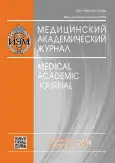THE INFLUENCE OF LASER RADIATION ON VEGF EXPRESSION IN THYROID TISSUE IN EXPERIMENTAL HYPOTHYROIDISM
- Authors: Golovneva ES1, Smelova IV2
-
Affiliations:
- South Ural State Medical University, Chelyabinsk
- Multidisciplinary Center for Laser Medicine, Chelyabinsk
- Issue: Vol 19, No 1S (2019)
- Pages: 145-146
- Section: Articles
- Published: 15.12.2019
- URL: https://journals.eco-vector.com/MAJ/article/view/19370
- ID: 19370
Cite item
Abstract
The aim was to study the effect of infrared laser irradiation of average intensity with the total dose of 112 J/cm2 and 450 J/cm2 on the expression of vascular endothelial growth factor (VEGF) in thyroid tissue in normal and hypothyroidism. The experiment was conducted on 30 male laboratory rats. Animals were removed from the experiment one day after irradiation. Expression of vascular endothelial growth factor was determined by immunohistochemical method. It was shown that laser exposure in the studied doses increases the expression of VEGF in the thyroid gland of intact animals and, to a greater extent, in hypothyroid animal groups. When comparing the effects of the two studied modes of laser exposure, it was found that VEGF expression is greater after exposition to the total dose density of 450 J/cm2 on the skin surface. The obtained results could be used for further development of laser therapy methods for hypothyroidism in experiment.
Keywords
Full Text
About the authors
E S Golovneva
South Ural State Medical University, Chelyabinsk
I V Smelova
Multidisciplinary Center for Laser Medicine, Chelyabinsk
References
- Isman CA, Yegen BC, Alican I. Methimazole-induced hypothyroidism in rats ameliorates oxidative injury in experimental colitis. J. Endocrinol. 2003;177(3):471-476.
- Winter R, Dungel P, Reischies F. Photobiomodulation (PBM) promotes angiogenesis in vitro and in chick embryo chorioallantoic membrane model. Sci Rep. 2018;8(1):170-180.
Supplementary files







